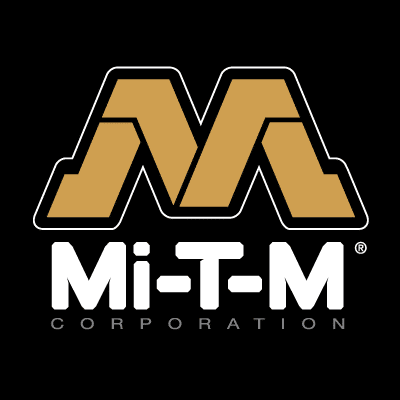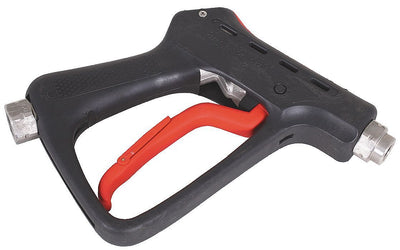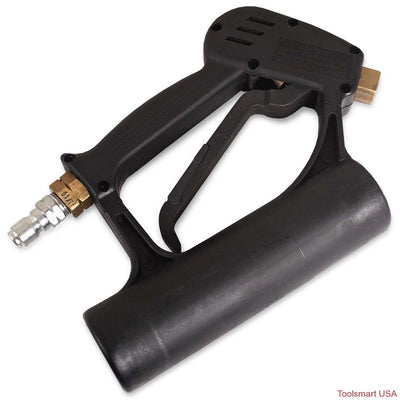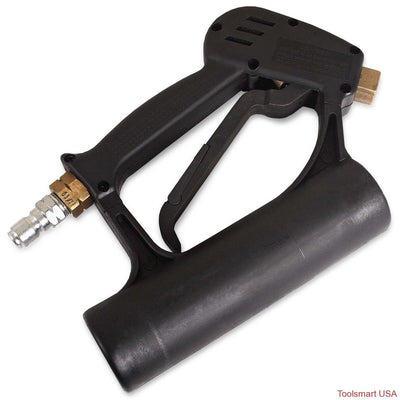How to Choose A Spray Gun
A Spray Gun can make a tremendous difference in your production and finish quality. To maximize your benefit from your spray gun it is important to choose the proper spray gun for your application needs. By considering the following factors you can choose a spray gun that will properly meet your finishing needs.
- What materials will you primarily spray? – Coatings will be the key to knowing the proper type of spray gun to use whether it be HVLP or Conventional, Gravity, Suction, or Pressure fed, and the proper fluid nozzle size to use. While it is ultimately best to test the material with your spray gun to best determine if it will work well for you, you can also generally choose well by evaluating the following. Is the material very heavy bodied like a heavy zinc, epoxy, coal tar, or glue? Most likely you will need a conventional spray gun. This will allow application of a lot of air pressure to atomize the material. Conventional Spray Guns are also cheaper than HVLP Spray Guns which make them a good choice if you think that maintaining the equipment well will be a challenge. Is the material medium to light viscosity (stains, enamels, lacquers, polyurethanes, auto body paints, industrial primers, topcoats, sealers ) you can often spray these effectively with HVLP Spray Guns (which will waste less paint than conventional spray guns). With lighter bodied materials you can also spray them effectively using suction or gravity fed spray guns in HVLP or Conventional application styles (heavy bodied materials will require significant thinning down to spray well from suction or gravity fed spray guns). If you will be spraying a lot of different materials you can find guns like the Binks Trophy Spray Gun that allow for using it as a conventional or HVLP Spray Gun by changing the air cap.
- How much production are you looking to achieve? – This question will help you answer the proper air cap and fluid nozzle setup to apply with your spray gun as well as if pressure fed is better for you than gravity or suction fed spray guns. Essentially the larger the fluid nozzle the quicker the spray gun will apply coatings and the better able it will be to apply heavy coatings. If your spraying Zincs, Epoxies, coal tar, or heavy enamels consider a large fluid nozzle (like a 1.4 – 1.8 ). With lighter coatings typically the challenge is not over applying coating and a small fluid nozzle will be best. Light coatings include stains and sealers, which often use a fluid tip of a 1.0 or 1.2. In addition to the fluid nozzle the air cap will need to be properly matched to your spray gun. The more CFM an air Cap handles the larger the production ability of the air cap (it will break up more coating faster). If you have a large nozzle you will need a large air cap and if you have a small nozzle you typically will want a smaller air cap. When it comes to the spray gun technologies pressure fed spray guns are the fastest with gravity and suction being about the same production speed.
- Will you spray regularly or just a single project? – This question will help you decide whether a high quality spray gun or a budget spray gun will make sense. Often times people will buy the low priced spray gun and continually replace it. However, this can often be more expensive than they might think over the long term as a high quality spray gun will be kept for a lifetime and require only occasional replacement of a part. Additionally higher quality spray guns will maintain a uniform spray pattern over multiple uses. If you want to further evaluate a budget vs higher qualty spray gun check out this article on why spray guns vary in price.
By considering these 3 things you should be able to best determine the proper spray gun for you you can also check out Binks guide here If you need further help let us know and we can learn more about your finishing needs and what spray gun might be a good fit for you.








